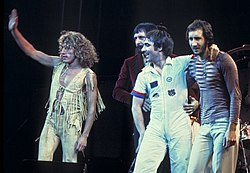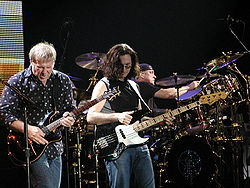Hard rock
Hard rock is a form of loud, aggressive rock music. The electric guitar is often emphasised, used with distortion and other effects, both as a rhythm instrument using simple repetitive riffs, and as a solo lead instrument.[1] Drumming characteristically focuses on driving rhythms, strong bass drum and a backbeat on snare, sometimes using cymbals for emphasis.[2] The bass guitar works in conjunction with the drums, occasionally playing riffs, but usually providing a backing for the rhythm and lead guitars.[3] Vocals are often growling, raspy, or involve screaming or wailing, sometimes in a high range, or even falsetto voice.[4] Hard rock has sometimes been labelled cock rock for its emphasis on overt masculinity and sexuality and because it has historically been predominately performed and consumed by men: in the case of its audience, particularly white, working-class adolescents.[2]In the late 1960s the term heavy metal was used interchangeably with hard rock, but gradually began to be used to describe music played with even more volume and intensity.[5] While hard rock maintained a bluesy rock and roll identity, including some swing in the back beat and riffs that tended to outline chord progressions in their hooks, heavy metal's riffs often functioned as stand-alone melodies and had no swing in them.[1][6] Heavy metal took on "darker" characteristics after Black Sabbath's breakthrough in the early 1970s and from the 1980s it developed a number of sub-genres, often termed extreme metal, which were influenced by hardcore punk, and which further differentiated the two styles.[3] Despite this differentiation, hard rock and heavy metal have existed side by side, with bands frequently standing on the boundary of, or crossing between, the genres.[7]
Origins (1960s)

The Who on stage in 1975.
Blues-rock acts that pioneered the sound included Cream, Jimi Hendrix Experience and The Jeff Beck Group.[1] Cream, in songs like "I Feel Free" (1966) combined blues-rock with pop and psychedelia, particularly in the riffs and guitar solos of Eric Clapton.[11] Jimi Hendrix produced a form of blues-influenced psychedelic rock, which combined elements of jazz, blues and rock and roll.[12] From 1967 Jeff Beck brought lead guitar to new heights of technical virtuosity and moved blues-rock in the direction of heavy rock with his band, The Jeff Beck Group.[13] Dave Davies of the Kinks, Keith Richards of the Rolling Stones, Pete Townshend of The Who, Hendrix, Clapton and Beck all pioneered the use of new guitar effects like phasing, feedback and distortion.[14] Even The Beatles attempted to produce songs in the new hard rock style, trying to create a greater level of noise than The Who, from The Beatles (1968) (known as the White Album) onwards, beginning with "Helter Skelter".[15] Some critics have written about its "proto-metal roar",[16] but others have argued that "their attempts at the heavy style were without exception embarrassing".[15]
Groups that emerged from the American psychedelic scene about the same time included Iron Butterfly, MC5, Blue Cheer and Vanilla Fudge.[17] The San Francisco band Blue Cheer released a crude and distorted cover of Eddie Cochran's classic "Summertime Blues", from their debut album Vincebus Eruptum (1968), that outlined much of the later hard rock and heavy metal sound.[17] The same month, Steppenwolf released its self-titled debut album (1968), including "Born to Be Wild", which contained the first lyrical reference to heavy metal and helped popularise the style when it was used in the film Easy Rider (1969).[17] Iron Butterfly's In-A-Gadda-Da-Vida (1968), with its 17-minute-long title track, using organs and with a lengthy drum solo, also prefigured later elements of the sound.[17]
At the end of the decade a distinct genre of hard rock was emerging with bands like Led Zeppelin, who mixed the music of early rock bands with a more hard-edged form of blues rock and acid rock on their first two albums Led Zeppelin (1969) and Led Zeppelin II (1969), and Deep Purple, who achieved their commercial breakthrough with their fourth and distinctively heavier album, In Rock (1970). Also significant was Black Sabbath's Paranoid (1970), which combined guitar riffs with dissonance and more explicit references to the occult and elements of Gothic horror.[18] All three of these bands have been seen as pivotal in the development of heavy metal, but where metal further accentuated the intensity of the music, with bands like Judas Priest following Sabbath's lead into territory that was often "darker and more menacing", hard rock tended to continue to remain the more exuberant, good-time music.[1]
[edit] Expansion (1970s)
In the early 1970s the Rolling Stones developed their hard rock sound with Exile on Main St. (1972). Initially receiving mixed reviews, according to critic Steve Erlewine it is now "generally regarded as the Rolling Stones' finest album".[19] They continued to pursue the riff-heavy sound on albums including It's Only Rock 'n' Roll (1974) and Black and Blue (1976).[20] Led Zeppelin began to mix elements of world and folk music into their hard rock from Led Zeppelin III (1970) and Led Zeppelin IV (1971). The latter included the track "Stairway to Heaven", which would become the most played song in the history of album-oriented radio.[21] Deep Purple continued to define hard rock, particularly with their album Machine Head (1972), which included the tracks "Highway Star" and "Smoke on the Water".[22] In 1975 guitarist Ritchie Blackmore left, going on to form Rainbow and after the break-up of the band the next year, vocalist David Coverdale formed Whitesnake.[23] 1970 saw The Who release Live at Leeds, often seen as the archetypal hard rock live album, and the following year they released their highly-acclaimed album Who's Next, which mixed heavy rock with extensive use of synthesisers.[24] Subsequent albums, including Quadrophenia (1973), built on this sound before Who Are You (1978), their last album before the death of pioneering rock drummer Keith Moon later that year.[25]Emerging British acts included Free, who released their signature song "All Right Now" (1970), which has received extensive radio airplay in both the UK and US.[26] After the breakup of the band in 1973, vocalist Paul Rodgers joined supergroup Bad Company, whose eponymous first album (1974) was an international hit.[27] Scottish band Nazareth released their self-titled début album in 1970, producing a blend of hard rock and pop that would culminate in their best selling, Hair of the Dog (1975), which contained the proto-power ballad "Love Hurts".[27] The mixture of hard rock and progressive rock, evident in the works of Led Zeppelin and Deep Purple, was pursued more directly by bands like Uriah Heep and Argent.[28] Having enjoyed some national success in the early 1970s, Queen, after the release of Sheer Heart Attack (1974) and A Night at the Opera (1975), gained international recognition with a sound that used layered vocals and guitars and mixed hard rock with glam rock, heavy metal, progressive rock, and even opera.[29] The latter featured the single "Bohemian Rhapsody", which stayed at #1 in the UK charts for nine weeks.[30]

Kiss onstage in Boston in 2004.














0 komentar:
Posting Komentar